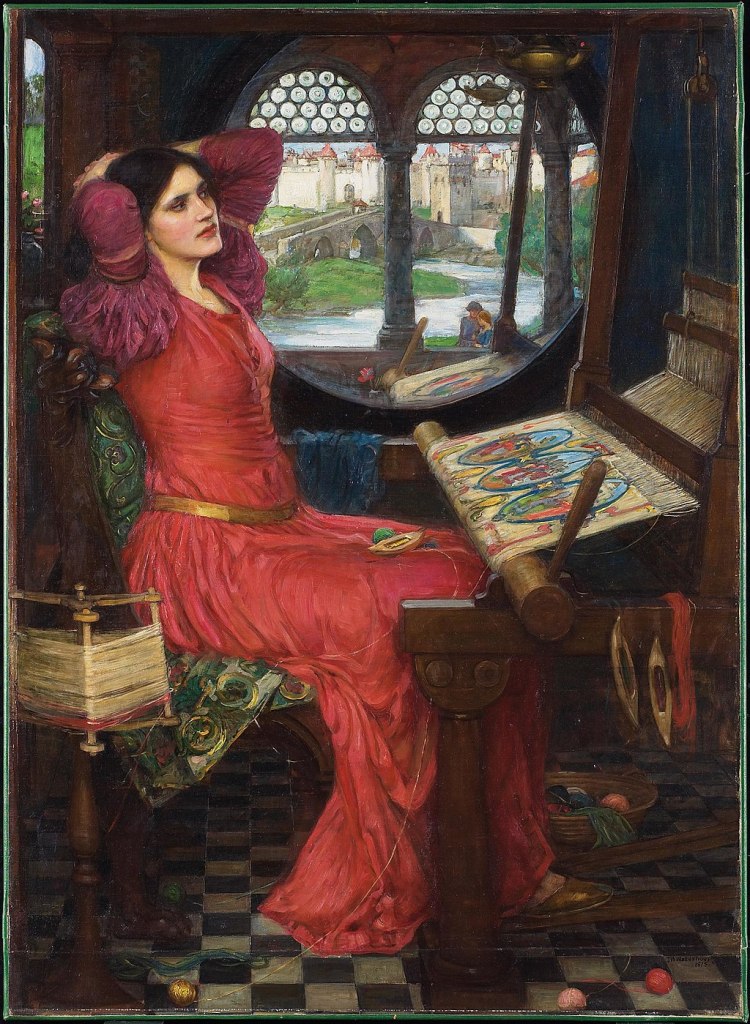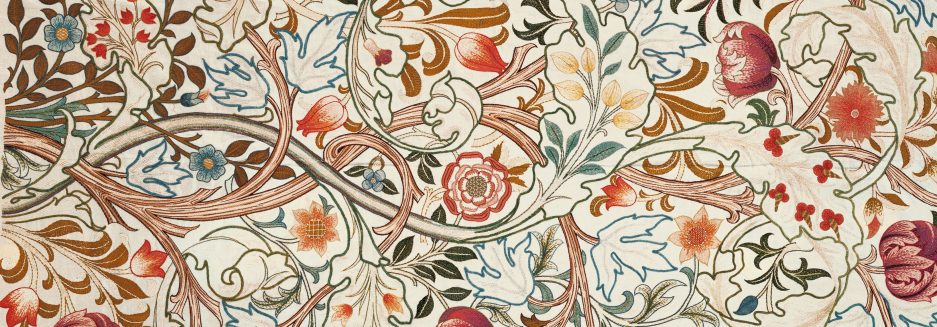During the next four months I will be studying “The Lady of Shalott,” by Alfred, Lord Tennyson. The first two posts will feature the complete poem alongside artwork and music. The final two posts will be summaries of my research on the background of the poem, its connection to Arthurian legend (also called the Matter of Britain), and what it tells us about storytelling. I encourage you to read the poem carefully, perhaps over a cup of something hot, and then examine the artwork closely. Begin by looking at the big picture, then notice the details. Finally, zoom out again and sit with the painting as a whole. You can use this exercise with the poem as well. Reading each post and enjoying each painting should take no more than fifteen minutes (one coffee break, to be precise). If you wish to read the entire poem immediately, click here.
~*~

The Lady of Shalott
by Alfred, Lord Tennyson
Part I
On either side the river lie
Long fields of barley and of rye,
That clothe the wold and meet the sky;
And thro’ the field the road runs by
To many-tower’d Camelot;
And up and down the people go,
Gazing where the lilies blow
Round an island there below,
The island of Shalott.
Willows whiten, aspens quiver,
Little breezes dusk and shiver
Thro’ the wave that runs for ever
By the island in the river
Flowing down to Camelot.
Four gray walls, and four gray towers,
Overlook a space of flowers,
And the silent isle imbowers
The Lady of Shalott.
By the margin, willow veil’d,
Slide the heavy barges trail’d
By slow horses; and unhail’d
The shallop flitteth silken-sail’d
Skimming down to Camelot:
But who hath seen her wave her hand?
Or at the casement seen her stand?
Or is she known in all the land,
The Lady of Shalott?
Only reapers, reaping early
In among the bearded barley,
Hear a song that echoes cheerly
From the river winding clearly,
Down to tower’d Camelot:
And by the moon the reaper weary,
Piling sheaves in uplands airy,
Listening, whispers ” ‘Tis the fairy
Lady of Shalott.”
Part II
There she weaves by night and day
A magic web with colours gay.
She has heard a whisper say,
A curse is on her if she stay
To look down to Camelot.
She knows not what the curse may be,
And so she weaveth steadily,
And little other care hath she,
The Lady of Shalott.
And moving thro’ a mirror clear
That hangs before her all the year,
Shadows of the world appear.
There she sees the highway near
Winding down to Camelot:
There the river eddy whirls,
And there the surly village-churls,
And the red cloaks of market girls,
Pass onward from Shalott.
Sometimes a troop of damsels glad,
An abbot on an ambling pad,
Sometimes a curly shepherd-lad,
Or long-hair’d page in crimson clad,
Goes by to tower’d Camelot;
And sometimes thro’ the mirror blue
The knights come riding two and two:
She hath no loyal knight and true,
The Lady of Shalott.
But in her web she still delights
To weave the mirror’s magic sights,
For often thro’ the silent nights
A funeral, with plumes and lights
And music, went to Camelot:
Or when the moon was overhead,
Came two young lovers lately wed:
“I am half sick of shadows,” said
The Lady of Shalott.
Loreena McKennitt is a Canadian composer and singer. She has composed music for a couple famous ballads, including “The Lady of Shalott,” by Alfred, Lord Tennyson and “The Highwayman,” by Alfred Noyes. Her marvellous composition of “The Lady of Shalott” is well-worth listening to. The complete version, in which she sings the entire ballad, is linked below. You can listen to her composition of “The Highwayman” by clicking here.
